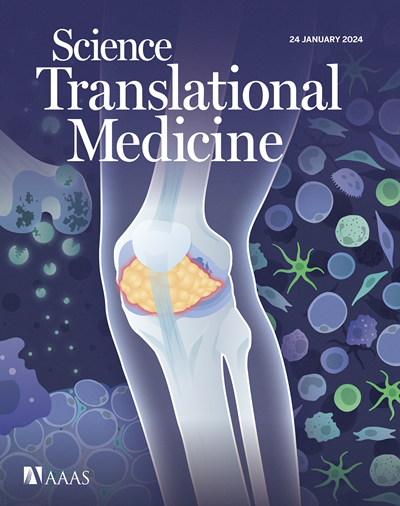Early detection of pancreatic cancer by a high-throughput protease-activated nanosensor assay
IF 15.8
1区 医学
Q1 CELL BIOLOGY
引用次数: 0
Abstract
Pancreatic ductal adenocarcinoma (PDAC) is among the top causes of cancer-related death. Patients are frequently diagnosed in the more advanced stages when effective treatment options are limited; however, earlier detection of PDAC by liquid biopsy may expand treatment options and improve survival outcomes. Here, we developed a noninvasive detection assay for PDAC based on serum protease activity to leverage the increase in cancer-associated protease activity in the peripheral blood of patients with PDAC. We screened a series of protease-cleavable peptide probes for the discrimination of PDAC samples versus healthy controls and noncancerous pancreatic disease. We identified a single MMP-sensitive probe, which could distinguish PDAC from controls with 79 ± 6% accuracy. We further developed this probe into a rapid magnetic nanosensor assay, termed PAC-MANN, that measures serum protease cleavage of a target-probe nanosensor with a simple fluorescent readout. In a longitudinal cohort of patients undergoing surgical removal of the primary tumor, the probe cleavage signal was reduced by 16 ± 24% after surgery. In a separate blinded retrospective study, the PAC-MANN assay identified PDAC samples with 98% specificity and 73% sensitivity across all stages and distinguished 100% of patients with noncancer pancreatic disease relative to patients with PDAC. The PAC-MANN assay combined with the clinical biomarker CA 19-9 was 85% sensitive for detection of stage I PDAC with 96% specificity. Therefore, the PAC-MANN assay is a rapid, high-throughput method that uses small blood volumes with the potential to enhance early PDAC detection, specifically among individuals at high risk of developing PDAC.胰腺导管腺癌(PDAC)是导致癌症相关死亡的首要原因之一。患者通常在晚期才被确诊,此时有效的治疗方案有限;然而,通过液体活检及早发现 PDAC 可能会扩大治疗方案并改善生存结果。在此,我们利用 PDAC 患者外周血中癌症相关蛋白酶活性的增加,开发了一种基于血清蛋白酶活性的 PDAC 无创检测试剂盒。我们筛选了一系列蛋白酶可切除肽探针,用于区分 PDAC 样品与健康对照和非癌症胰腺疾病。我们发现了一种对 MMP 敏感的探针,它能以 79 ± 6% 的准确率将 PDAC 与对照组区分开来。我们进一步将该探针开发成了一种快速磁性纳米传感器检测方法,称为 PAC-MANN,它能通过简单的荧光读数测量血清蛋白酶对靶标探针纳米传感器的裂解。在接受原发性肿瘤手术切除的患者纵向队列中,手术后探针裂解信号降低了 16 ± 24%。在另一项盲法回顾性研究中,PAC-MANN 检测法对所有分期的 PDAC 样本的鉴定特异性为 98%,灵敏度为 73%,100% 的非癌症胰腺疾病患者可被区分为 PDAC 患者。PAC-MANN 检测与临床生物标记物 CA 19-9 联合使用,对 I 期 PDAC 的检测灵敏度为 85%,特异性为 96%。因此,PAC-MANN 分析是一种快速、高通量的方法,只需少量血液,就能提高早期 PDAC 的检测率,尤其是对 PDAC 高危人群的检测率。
本文章由计算机程序翻译,如有差异,请以英文原文为准。
求助全文
约1分钟内获得全文
求助全文
来源期刊

Science Translational Medicine
CELL BIOLOGY-MEDICINE, RESEARCH & EXPERIMENTAL
CiteScore
26.70
自引率
1.20%
发文量
309
审稿时长
1.7 months
期刊介绍:
Science Translational Medicine is an online journal that focuses on publishing research at the intersection of science, engineering, and medicine. The goal of the journal is to promote human health by providing a platform for researchers from various disciplines to communicate their latest advancements in biomedical, translational, and clinical research.
The journal aims to address the slow translation of scientific knowledge into effective treatments and health measures. It publishes articles that fill the knowledge gaps between preclinical research and medical applications, with a focus on accelerating the translation of knowledge into new ways of preventing, diagnosing, and treating human diseases.
The scope of Science Translational Medicine includes various areas such as cardiovascular disease, immunology/vaccines, metabolism/diabetes/obesity, neuroscience/neurology/psychiatry, cancer, infectious diseases, policy, behavior, bioengineering, chemical genomics/drug discovery, imaging, applied physical sciences, medical nanotechnology, drug delivery, biomarkers, gene therapy/regenerative medicine, toxicology and pharmacokinetics, data mining, cell culture, animal and human studies, medical informatics, and other interdisciplinary approaches to medicine.
The target audience of the journal includes researchers and management in academia, government, and the biotechnology and pharmaceutical industries. It is also relevant to physician scientists, regulators, policy makers, investors, business developers, and funding agencies.
 求助内容:
求助内容: 应助结果提醒方式:
应助结果提醒方式:


